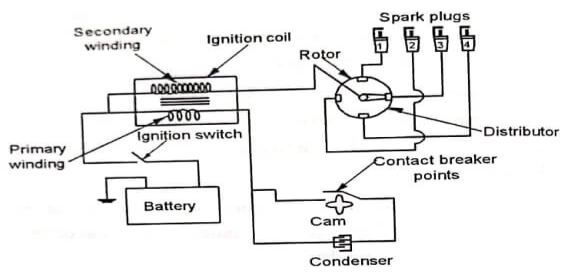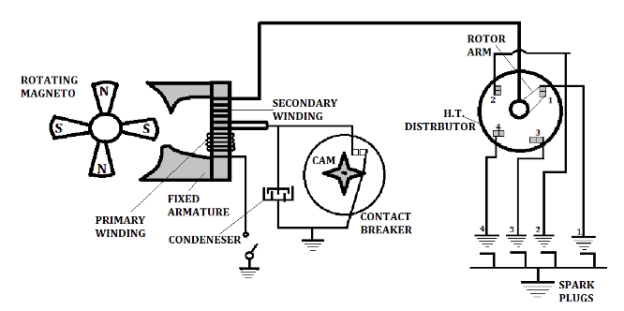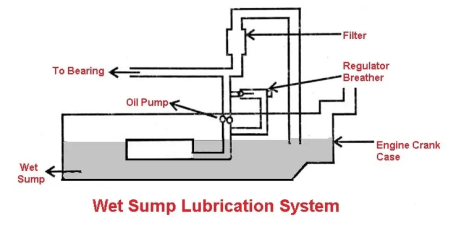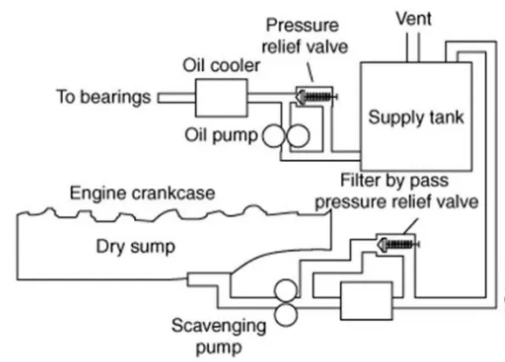Unit - 5
Ignition system
Q1) Explain battery ignition system.
A1)
Battery Ignition System:
The widest software for spark ignition internal combustion engines is in petrol (gasoline) road motors including motors and motorcycles. Compression ignition Diesel engines ignite the fuel-air mixture thru the warm temperature of compression and do now not need a spark. They generally have glow plugs that preheat the combustion chamber to allow starting in cold weather. Other engines may additionally use a flame, or a heated tube, for ignition.
While this come to be now no longer unusual place for extraordinarily early engines it is now rare. The essential components with inside the ignition tool are a storage battery, an induction coil, a device to offer timed immoderate-voltage discharges from the induction coil, a distributor, and a set of spark plugs. The storage battery provides an electric powered current of low voltage (generally 12 volts) that is converted thru the tool to immoderate voltage (some 40,000 volts). The distributor routes the successive bursts of immoderate-voltage current to each spark plug with inside the firing order.
Many automobile engines now use a distributor-a lot much less ignition tool, or direct-ignition tool, in which a immoderate-voltage pulse is right now carried out to coils that sit down down on top of the spark plugs (called coil-on-plug). The most important components of these systems are a coil pack, an ignition module, a crankshaft reluctor ring, a magnetic sensor, and an virtual manipulate module. The ignition module controls the primary circuit to the coils, turning them on and off. The reluctor ring is set up on the crankshaft just so due to the fact the crankshaft rotates the magnetic sensor is delivered on thru notches with inside the reluctor ring. The magnetic sensor provides function statistics to the virtual manipulate module, which governs ignition timing.
A battery ignition gadget has a 6- or 12-volt battery charged with the resource of the use of an engine-driven generator to supply electricity, an ignition coil to boom the voltage, a device to interrupt modern from the coil, a distributor to direct modern to the ideal cylinder, and a spark plug projecting into each cylinder.
Q2) Explain parts of battery ignition system.
A2)
Parts of Battery Ignition System:
The main components of Battery Ignition system are listed below:
- Ignition switch
- Battery
- Ignition coil
- Ballast resistor
- Contact breaker
- Distributor
- Capacitor
- Spark Plug

Fig: Battery Ignition System
Q3) Explain various terms in battery ignition system.
A3)
1. Ignition Switch:
It is used for ON or OFF the engine. One quit of the transfer is attached with the Primary Winding of Ignition Coil thru Ballast Resistor, and some other quit is attached with the Battery. Basically whilst the secret is placed interior it and became the transfer in ON function then the circuit is completed (Close Circuit), and whilst moved in the direction of the OFF function than its paintings as an open circuit. Nowadays, this transfer is changed via way of means of the Push Button, and this device is referred to as a keyless device.
2. Battery:
Although there are Zinc Acid Battery and Lithium-Ion Battery is carried out in contemporary-day vehicles. The voltage of the battery is between 6V to 12V or 24V.
3. Ignition coil:
t is running as a step-up transformer, and feature winds, one is number one that have a lesser turn, and the opposite one is secondary that have a better quantity of turn. It is the most important part of battery ignition system.
4. Ballast resistor:
This is used to restriction the modern-day with inside the ignition circuit and typically manufactured from Iron. It is located in collection among the Ignition Switch and Ignition Coil.
5. Contact Breaker:
The touch breaker is an electrical transfer that's regulated through the cam and while the breaker is open, modern flows thru the condenser and expenses it.
6. Distributor:
It is used with inside the multi-cylinder engine, and its reason is to modify spark in every spark plug at the appropriate sequence.
There are two types of distributors.
- Carbon Brush Type
- Gap Type
Carbon Brush Type:
It is consist of Carbon Brush which is slides over the metallic section inserted in the distributor cap.
Gap Type:
In this type, the rotor arm is surpassed via the steel phase of the distributor cap however it does now no longer contact the floor of the distributor cap. That’s why it's far referred to as Gap Type Distributor.
7. Capacitor:
A capacitor is a storing tool wherein electric electricity is stored. It is equipped parallel to the touch breaker, while the present day drops then it provided the extra present day in order that the spark is produced. It is made from metallic plates separated through air or every other insulating material.
8. Spark Plug:
It is very crucial and important part of system which able to ignite all system at its own.
Q4) Explain the working principle of battery ignition system.
A4)
Working Principle of Battery Ignition System:
In Battery Ignition System, while the Ignition Switch is became on then the modern will flows to the number one circuit thru ballast register, number one winding and call breaker The flowing modern brought about a magnetic area across the number one winding, the greater modern we deliver the greater magnetic field will generate. At a positive time, the touch breaker opens the modern is flowing thru the number one winding and fall. Due to this significant quantity of voltage the capacitor comes into the charging country while the capacitor charged completely then it begins off evolved turning in the modern toward the battery, because of this opposite flowing of the modern and already brought about magnetic area with inside the number one winding, a completely excessive voltage of 15000 V to 30000 V is generated with inside the secondary winding.
Advantages of Battery Ignition System:
These are the following advantages of Battery Ignition System:
• The depth of spark is good.
• It also can offer a excessive attention of spark even in low engine pace or beginning of Engine.
• The renovation of this ignition gadget may be very much less in comparison to others.
Disadvantages of Battery Ignition System:
The disadvantages are:
• Efficiency reduced with a discount in spark intensity.
• Occupies greater space.
• Efficiency reduced with a discount in spark intensity.
Applications of Battery Ignition System:
Here is the application of it:
Battery Ignition System is used in Automobile (Car, Bus, Truck even in the Bike) to produce the Spark so that Combustion fuel can be burned.
Q5) What is magneto ignition system?
A5)
Magneto Ignition System:
Magneto ignition device is an ignition device wherein magneto is used [produces high voltage] for the technology of energy and similarly that energy is utilized in numerous such things as to run the vehicles. This is essentially utilized in two-wheeler vehicles (Spark Ignition Engine) nowadays.

Parts of Magneto Ignition System:
The main parts of Magneto Ignition System are:
- Transformer core
- Contact Breaker
- Cam
- Capacitor
- Ignition Switch
- Distributor
- Spark Plug
1. Transformer core:
There are two types of winding we can see in Magneto Ignition System, those are:
a. Primary Winding: The main function of this winding is to draw the power from the source.
b. Secondary Winding: This winding has more turns of wire (the number is 1000 of turns of wire) as compared to the primary winding. This is connected to the Distributor (Which is having a rotor).
2. Contact Breaker:
The contact breaker is operated by cam and when breaker opens current flows through it.
3. Cam:
Cam is connected to the North and south magnet.
4. Capacitor:
Main work of it is to store charge. And here electric type capacitor issued.
5. Ignition switch:
For operating purpose like switch on and off this part is used.
6. Distributor:
This is connected to the spark plug and Distributor having the rotor.
7. Spark Plug:
The main work of the spark plug is firing the explosive mixture in the IC engine.
Q6) Explain working principle of magneto ignition system.
A6)
Working Principle of Magneto Ignition System:
When the engine of the machine starts, it permits the magneto to rotate and as a end result it’s producing the energy with inside the form of immoderate voltage then, one cease of the magneto is grounded thru a hint breaker, and the ignition capacitor is installed to its parallel. The contact breaker is regulated thru manner of way of the cam and while the breaker is open, current flows thru the capacitor and charges it. Now the capacitor is acting as a charger now, the primary current go with the flow is reduced, as a end result decreasing the overall magnetic field, generated with inside the machine. This will growth the voltage with inside the capacitor. This accelerated immoderate voltage with inside the capacitor will act as an EMF as a end result producing the spark, at the right spark plug thru the distributor. And on the start stage, the speed of the engine is low and consequently the voltage generated thru manner of way of the magneto is low. But due to the fact the rotating tempo of the engine will growth, it moreover will growth the voltage generated thru manner of way of the magneto as a end result the go with the flow of the current is also accelerated.
Advantages of Magneto Ignition System:
These are the following advantages of Magneto Ignition System:
• This gadget calls for much less preservation in comparison to the Battery ignition gadget.
• This is extra beneficial due to the fact no battery is used.
• It occupies much less space.
• An electric powered circuit is generated with the aid of using the magneto
• No battery is needed, so no trouble of battery discharge
• Efficiency improves because of high-depth spark.
Disadvantages of Magneto Ignition System:
Although there are some disadvantages:
• During starting, the best of spark is negative because of low speed.
• This is a bit costly compared to some other ignition system.
Applications of Magneto Ignition System:
Magneto Ignition System nowadays widely used in:
• This machine is used for the era of electricity (In case of Battery machine their Battery is used) and to run the vehicles.
• This is largely utilized in two-wheeler vehicles (SI Engine) nowadays.
• A rotating magnet produces excessive voltage.
• And additionally that is utilized in diverse locations like: Tractors, Outboard Motors, Washing Machines, Buses, Power Units, Marine Engines, and Natural Gas Engines.
Q7) Explain firing order in detail.
A7)
Firing order:
The firing order of an internal combustion engine is the collection of ignition for the cylinders. In a spark ignition (e.g. Fuel/petrol) engine, the firing order corresponds to the order in which the spark plugs are operated.
Four-stroke engines must moreover time the valve openings relative to the firing order, due to the fact the valves do now not open and close to on every stroke.
The numbering tool for cylinders is commonly based totally definitely on the cylinder numbers developing from the thethe front to the rear of an engine (See engine orientation below).
Straight engine
Cylinders numbered from front (#1 cylinder) to rear.
V engine
V engine with cylinder numbering primarily based totally on crankshaft function (rather than following every cylinder financial institution) The front most cylinder is generally #1, but there are not unusual place approaches:
Numbering the cylinders primarily based totally on their function alongside the crankshaft (e.g. 1-3-5-7 alongside the proper financial institution and 2-for-6-eight alongside the left financial institution). This method is usually utilized by V8 engines from General Motors, and Chrysler. The choice of whether or not the number one cylinder is at the left financial institution or proper financial institution generally relies upon on which financial institution is in the direction of the front of the crankshaft.
However, the Ford Flathead V8 and Pontiac V8 engine truly have the number one cylinder at the back of the cylinder from the alternative financial institution.
His become executed so that everyone Ford engines might have cylinder #1 at the proper financial institution and all Pontiac engines might have cylinder #1 at the left financial institution, to simplify the system of figuring out the cylinders.
Radial engine
The cylinders are numbered around the circle, in clockwise direction with the #1 cylinder at the top.
Q8) Explain quality, quantity and hit and miss governing.
A8)
Quality, Quantity and hit and miss governing:
Governing:
The manner of imparting any arrangement, a good way to maintain the engine velocity constant (in keeping with the converting load conditions) is called governing of I.C. Engines. The manner of imparting any arrangement, a good way to maintain the engine velocity though there are numerous strategies for the governing of I.C. Engines, but the subsequent are important:
1. Hit and miss governing.
In this gadget of governing, each time the engine begins offevolved strolling at better speed (because of reduced load), a few explosions are neglected or missed. This is achieved with the assist of a centrifugal governor. This technique of governing is extensively used for I. C. Engines of smaller capability or fueloline engines.
2. Qualitative governing.
In this machine of governing, a manage valve is outfitted with inside the gas shipping pipe, which controls the amount of gas to be blended with inside the charge. The motion of manage valve is regulated with the aid of using the centrifugal governor thru rack and pinion arrangement.
3. Quantitative governing.
In this gadget of goverliing, the exceptional of charge (i.e. air-fuel ratio of the mixture) is stored constant. But the quantity of mixture provided to the engine cylinder is numerous with the aid of using the usage of a throttle valve this is regulated via the centrifugal governor through rack and pinion arrangement.
4. Combination system of governing.
In this system of governing, the qualitative and quantitative methods of governing are combined together.
Q9) What is lubrication and cooling.
A9)
Lubrication and cooling system:
Lubricating structures are structures used to help the easy and wholesome operation of rotating equipment components like gears, bearings, dies, chains, spindles, cables, pumps, and rails.
• Without lubricating structures, many commercial enterprise and manufacturing strategies may want to place on down from friction, overheating, and generally require maintenance lots more quickly. (Without lubrication, commercial enterprise bearings rarely closing more than 10% of their functionality lifestyles span.)
• Machinery that requires constant maintenance will growth production downtime and negatively influences commercial enterprise productivity usual. Some US-based absolutely estimates feature a hint over 50% of usual commercial enterprise bearing screw ups to a lack of proper lubrication.
Q10) Explain wet sump lubrication system?
A10)
Wet Sump Lubrication System
The moist sump machine is not unusual place and popular oil sump in an vehicle engine. It’s referred to as moist-sump as it incorporates oil in only the sump, serving as a reservoir and it makes use of a unmarried oil pump. Oil circulating method appears to speedy on this lubricating machine due to the fact the oil is pumped from at once to the transferring parts. The sump is fabricated from skinny formed stainless metallic that is used to cowl the engine beneath. It collects the oil while the engine is at rest. Wet sumps are formed into deeper segment and it’s installed at the lowest of the crankcase serving as oil storage/reservoir. Though oil staving regularly takes place there are approaches to save you it.

The engine is cowl completely, stopping outside dust from getting into. Oil sumps additionally assist with inside the cooling of lubricating warm oil because the automobile moves. There is airflow below the sump, which allows to chill the recent oil earlier than getting into the engine for lubrication. There are cooling fins with inside the sump which growth its floor area. Oil sumps assist to maintain massive dust and save you them from getting into the engine. Small dust is saved with the aid of using the oil filter. The oil it incorporates is used for lubrication, cooling, and cleansing of the engine. With a dipstick, oil sump permits the oil to be a gauge. Oil pan/sump permits oil to empty out so new oil may be installed.
Q11) What is dry sump lubrication?
A11)
Dry Sump Lubrication
In a dry-sump lubricating system, there's a further oil reservoir apart from the oil pan. It’s a manner to manipulate lubricating oil in each two-stroke and four-stroke inner combustion engine. Oil is pumped at special ranges with inside the system, at at the very least two, with as many as five or 6. The subsequent degree is scavenging the oil out of the dry-sump pan and returning the oil and gases to the outside reservoir.

Fig: Dry Sump Lubrication System
This document was truncated here because it was created in the Evaluation Mode.